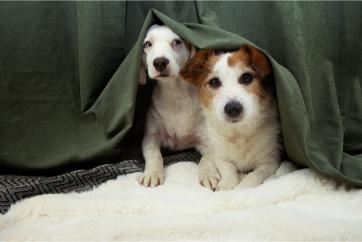Frightened Furry Friends: Keeping Pets Safe During Firework Season

Most people “ooh” and “ahh” at the visual and aural effects of firework displays. Pets, on the other hand, tend to run for cover long before the first blast fizzles out. Because of their intensity and unpredictability, animals really don’t know what to make of the pops, cracks, fizzes, whistles, and booms of fireworks. Consequently, their fear, confusion, and stress trigger an innate fight-or-flight instinct that doesn’t always lead them to safety and security. With our Fourth of July safety tips, you can keep your pet happy, comfortable, and most importantly, safe.
The Scary Truth
Fireworks (and other loud noises, like thunderstorms, construction work, and traffic) can be so frightening to pets that they run away. Becoming lost or separated during the Fourth of July is already chaotic and terrifying, but the stress can also lead to some life-threatening outcomes. While fleeing, pets can dart into roadways, come into contact with predators, or suffer other grave injuries.
A Friendly Reminder
Pet-proofing the home and yard is a year-long effort, but it is crucial to check on window screens and door seals before any known triggers, such as the Fourth of July. If your dog digs under the fence, or your cat darts out of the front door while you’re leaving, take extra care this time of year to ensure they are secured indoors.
If your pet’s ID tags are showing some wear and tear, or your address or phone number has changed, be sure to purchase new, shiny tags for them to sport. Also, because collars can accidentally slip off or be removed, pet microchips provide an added layer of peace of mind. Again, update any contact information with the chip’s manufacturer if needed.
Being There
Ideally, pet owners are able to stay at home with their pets during firework shows to mitigate any stress or fear. If you’re unable to stay with them, ask a friend or neighbor to stop by and visit them as many times as possible. Crate training is especially helpful in this circumstance because pets actually feel protected while in their “den.”
Safe and Sound
Set up a room in the house that has few windows. Invite them to snuggle, sleep, play, eat, drink water or whatever makes them feel less stressed. Have their favorite bed and toys available, play soft music, and generally take cues from them about what they need.
If they are showing signs of intense fear or anxiety, stay with them until the source of their feelings subsides. Lead them outside of the room slowly and then out of the house if the noise level is back to normal. Never force a pet to leave the safety of the room. If needed, set up a litter box or puppy pads so they can relieve themselves.
The Long View
Pet anxiety can get worse if not properly addressed. If you have questions about your pet’s behavior, please give us a call at (916) 791‑8387. Our team at Bayside Animal Hospital is always happy to help your pet feel their very best.


